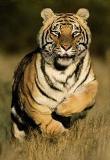 |
Select newsletter in right column
Newsletter 67
06/03/13
Wild Cheetah Return to the Free State of South Africa
after 100 Years
In the lowveld of South Africa, the cheetah
mother is moving her 5, three month old cubs in the late afternoon.
She has left it too late, it will be a costly mistake.
In the fading light, two male lions anticipate
the direction of the moving cheetah and set up an ambush. Silently
the males wait for the cheetah to come closer.
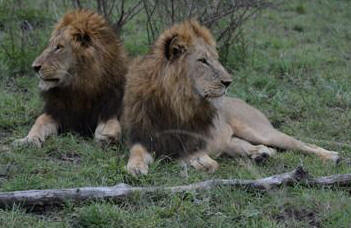
At 50 metres the male lions make their attack.
The cheetah mother tries to decoy the male lions by running in front
of them, but her young cubs are not quick enough. One cub perishes
in the jaws of the male lion.
Three cubs dive into the tall grass, their
mantles camouflaging with the grass. They remain silent and
motionless.
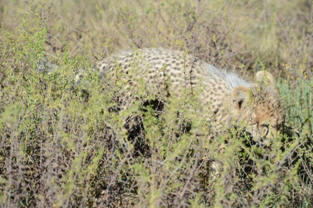
Young cheetah possesses a mantle which begins to disappear at three
months old. The mantle helps camouflage in the flowering grass
The fifth cub runs with his mother and survives.
The male lions do not eat the dead cub. They discard it, having
snapped its spine.
Now the male lions wait silently as the sun sets
across the lowveld of South Africa. An hour passes and then one of
the cubs makes a critical error, it chirps trying to locate its
mother. One of the male lions finds it easily and kills it with one
bite. Another hour goes by and a second cub grows impatient and
chirps for its mother. It suffers the same fate as the previous cub.
By morning all three cubs that had tried to hide plus the first cub
are all dead.
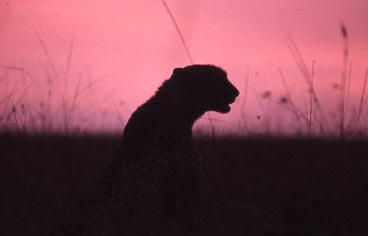
As the sun sets, the anxious cheetah mother waits nearby
The male lions move off, marking territory and
roaring as they go. There is no anger or hate, they have simply
removed a rival predator.
The cheetah mother returns with the surviving cub
and although her cubs are clearly dead she calls for them for the
next two days. It's a pitiful sight.
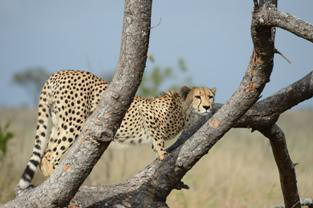
The mother cheetah calls for the cubs for the next 2 days
After two days, the cheetah mother must hunt for
herself and her remaining cub. As she stalks a herd of impala, the
cub elevates on a fallen marula tree to watch the hunt. Unbeknown to
the cheetah cub or its mother, they are being watched by a female
leopard lying in the leafy branches of an ebony tree.
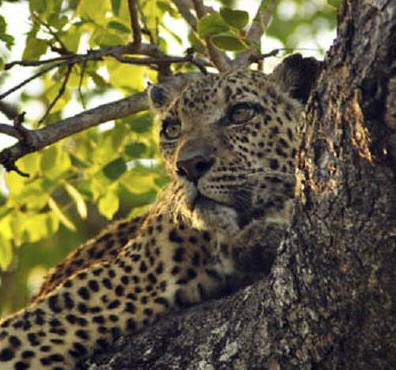
After lions, leopards are the biggest killers of cheetah cubs
The cheetah mother stalks through the tall grass
to within 80 metres of the unsuspecting impala. Suddenly she makes
her run, the long flexible spine gives her a huge stride. The
powerful legs drive her forward at 80 km per hour. Most of the time
her feet are clear of the ground as she literally flies through the
air. Her large nostrils feed her body with oxygen. The impala tries
to zig-zag to throw her off, but she is experienced. Her following
distance remains constant for 200 metres, then sensing the impala is
tiring she moves up a gear and closes with the impala. Her front leg
sweeps the legs from under the impala and she tumbles it. Before the
impala can recover she has it in her jaws. The cheetah canines close
over the windpipe blocking off the air supply. The exhausted impala
takes 11 minutes to die.
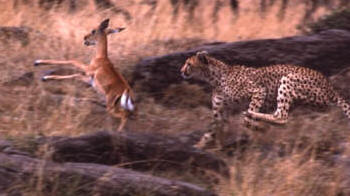
The cheetah mother prepares to swipe the legs from under the impala
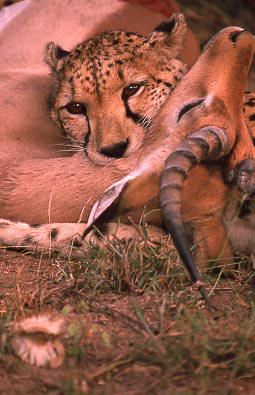
The cheetah has the weakest jaws of all the big cats. The exhausted
impala takes 11 minutes to die in the jaws of the cheetah
The cheetah cub now 600 metres away from its
mother, waits for its mother to call it to the kill. It never hears
the call. A quick leap into the marula tree and the leopard kills
the young cheetah. Like the lions, he does not eat the cub but
tosses it aside.
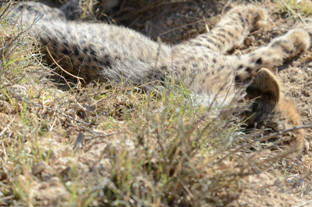
Like the lions, the leopard does not eat the dead cub.
The mother cheetah is calling for her cub to join
her at the kill. The leopard pin points the call and moves in. The
leopard at 50 kilograms easily takes the kill from the 40 kilogram
cheetah. In the last 72 hours, the mother cheetah has lost 5 cubs
and one impala kill.
The cheetah mother, still hungry moves off to
hunt again. This time she targets an adult female impala and once
again she is successful. Too exhausted to feed immediately, she
tries to recover herself. Two hooded vultures spot the kill out in
the open. Three spotted hyena see the vultures dropping down. They
move in at speed and once again drive the cheetah from her kill. It
is now 96 hours since she had her last feed.
In Kenya's Masai Mara, a cheetah mother and her
four, 3 months old cubs are hunting in the mid morning. This is the
time when rival predators should be least active. The cheetah mother
targets a herd of gazelles and gives chase.
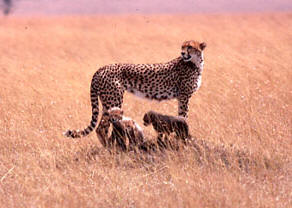
Cheetah mother with her 3 cubs
Still photographers, movies crews and tourist
cars chase after the running cheetah, eager to catch the moment when
the cheetah dramatically "paw swipes" the gazelle.
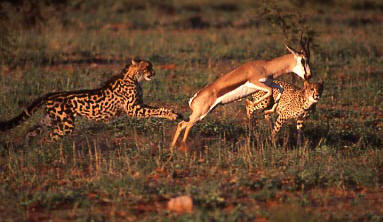
The King Cheetah prepares to paw swipe the springbuck as the normal
cheetah closes in
The cubs, unable to catch up with their mother,
drive into the tall grass. A tourist jeep runs right over one of the
hiding cubs, killing it instantly. The litter is down to 3. The
cheetah mother misses the gazelle and immediately calls up her cubs.
She cannot count and does not notice that one is missing.
After resting for 3 hours, she moves away to try
another hunt. The exhausted cubs remain sleeping in the tall grass.
To the west, the marsh pride is hunting a herd of
buffalo. Complete with adult males, the lionesses will strategize
the hunt and the males will assist with the kill. The buffalo flee
the approaching lions. 1,600 hooves are pounding through the tall
grass towards the sleeping cubs. Miraculously two cubs survive, but
one is trampled underfoot and dies immediately under the pounding
hooves. The litter is down to 2.
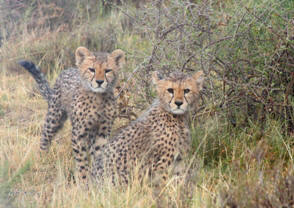
Two cubs remain from the litter of four
On her return, the cheetah mother sniffs the dead
cub. She chirps it, but it does not respond. She leads her two cubs
away. There is no burial as in the case of leopards or tigers.
The following day the cheetah mother is back
hunting. Her exhausted cubs remain hidden in the tall grass nearby.
Suddenly a fire, lit by Masai tribesman, who are burning the tall
grass for their cattle, starts to burn towards the hidden cubs,
Fanned by a strong wind the fire accelerated towards the
unsuspecting cubs.
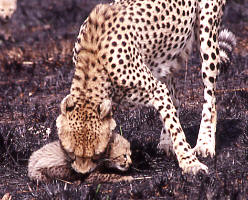
The cheetah mother saves one cub from the fire. However, the second
cub perishes in the flames
The cheetah mother realizing the danger, races
back to the cubs. She can only take one cub in her jaws. With cub in
her mouth she outruns the raging fire. The remaining cub perished in
the flames. The liter is down to one.
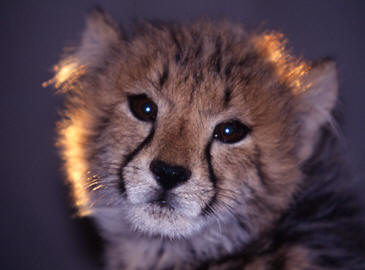
From the original litter of 4, one cub remains
In Namibia vast areas are under stock farming.
The farmers have destroyed the rival predators of the cheetah, the
lion, leopard and spotted hyenas. These are found only in the
national parks and private game reserves. Without the competition of
lion, leopard and spotted hyena the cheetah has thrived in Namibia.
However, the farmers have not only destroyed the
rival predators, they have removed the natural prey of the cheetah
as well. These have been replaced by slow moving sheep and goats.
The cheetah turn to this easy prey and the farmers in turn, destroy
the cheetah and so the vicious cycle continues.
Even in private game reserve in South Africa
where the habitat has been manipulated to suit the cheetah and prey
is abundant, the cheetah struggles to compete. In short it sits
firmly at the bottom of the predator hierarchy.
In Tanzania's Serengetti, the cheetah can lose
75% of their kills to lion, leopard and spotted hyena.
The fastest animal on the planet is becoming more
and more endangered.
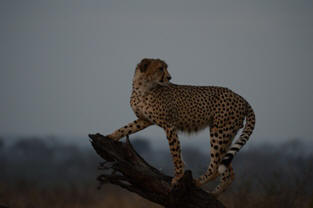
The cheetah sits firmly at the bottom of the predator hierarchy
I take great pleasure in announcing that for the
first time in 100 years, wild cheetah had been reintroduced into the
Free State Province of SA
Guests visiting Tiger Canyons can now see,
photograph and be inspired by two highly endangered cats, tiger and
cheetah.
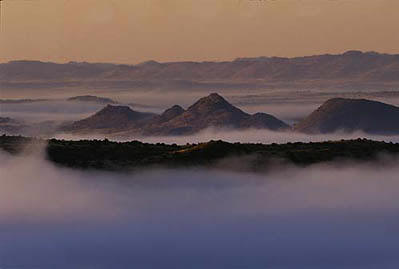
Tiger Canyons has large open grasslands, very suitable for cheetah
I would like to thank Rodney and Lorna Drew,
the Director of the Dept Economic Development, Tourism and
Environmental Affairs, Tseko Lephokogoe, the Environmental
Management Inspector, Werner Boing and Nature Conservation
Biodiversity Officer, Wimpy Geyer for their vision and support.
Tread Lightly on the Earth
JV
The Cheetah - Facts and Information about
the Cheetah in Africa
Cheetahs are the fastest
animals on earth, that's one fact that most
people know. But there's more to a cheetah than
speed alone. It's one of Africa's most beautiful
animals, and you are lucky if you get to see one
on safari. Find out all about cheetah in Africa,
including lots of fun facts below.
Speed - The Cheetah's
Greatest Asset
Everything about a cheetah's body is built for
speed. They have a flexible spine, large liver
and heart, wide nostrils, increased lung
capacity, and thin muscular body. They run so
fast and stride so long, that only one foot at a
time touches the ground. A recent study shows
that a sprinting cheetah uses the same mechanics
as a rear-wheel-drive car, all its power comes
from the back. The cheetah's hind limbs have
muscles and fibers suited to power running,
whereas those on its fore limbs are better for
steering and balance. Car manufacturers have got
it right thus far, but they're still struggling
to keep up with the cheetah on acceleration. A
cheetah can go from 0 - 60 mph in under three
seconds, an acceleration Porsche owners can only
dream about (they're currently at 4.1 seconds to
reach 60 mph).
But Speed Isn't Everything
...
Cheetah's are a bit different from other big
cats in Africa. For one, they hunt during the
day, so they avoid direct competition from
leopards and lions. The black tear marks below
their eyes keeps the bright sun light from
blinding them while they hunt. Unlike lions,
they are solitary animals and this makes them
more vulnerable to predators since the mother
has to leave her cubs alone while she hunts.
Only around 10% of cheetah cubs even make it to
adulthood. Cheetah's are not naturally
aggressive animals, they run from danger. This
makes it easy for other predators to take their
kill, and also their young. Cheetahs may be
speedy, but tire quickly and expend a lot of
energy hunting in this manner. An injury is a
disaster for the solitary cheetah.
Cheetah Conservation Status
If you combine some of the cheetah's innate
frailties, with pressure on its habitat from
farming, resulting in less prey as well as
reduced territory, it's not surprising to
discover that cheetah are on the IUCN Red List
listed as a "vulnerable" species. Many cheetah
populations have simply been wiped out by
farmers protecting their livestock. A key
component to future cheetah conservation is
therefore educating farmers about the cheetah,
and figuring out a way local communities can
benefit from potential tourism dollars spent by
those coming to see the cheetah in its natural
environment. The cheetah's beauty has also been
its curse, as poaching has taken its toll on
their numbers too. It is estimated that there
are around 12,000 cheetah left in the world
today.
Fun Cheetah Facts
-
There are only 10,000
cheetahs left in the wild (most of them in
Africa)
-
Cheetahs can reach a
sprinting speed of 114kph (71mph)
-
Cheetahs can purr, but
they can't roar
-
Cheetahs usually live for
about 12 years
-
A female cheetah raises
her cubs alone
-
When a cheetah runs, only
one foot at a time touches the ground
-
Cheetahs are not good
climbers
-
Cheetahs don't have fully
retractable claws
-
Algeria is home to 200
cheetahs
-
Outside of Africa, wild
cheetahs can only be spotted in Iran
-
A cheetah is not part of
the "Big Five" on safari, but should be if
the list was based on most desirable animals
to see on safari!
Where You Are Likely To
Spot a Cheetah on Safari?
Cheetah populations are thinly spread
throughout Africa over 25 countries, as far
north as Algeria, and as far south as South
Africa. There is also a small cheetah
population in Iran. Namibia in south west
Africa has the largest population, with an
estimated 3000 cheetah calling this large,
sparse country, home. Cheetahs are not so
easy to spot, you may have a better chance
if you go on safari in winter when the grass
is not so high on the open plains (see more
about Best Time to Go on Safari)
Cheetah Spotting in East
Africa
The best places to take a safari if you want
to see cheetahs in the wild include
Tanzania's Serengeti National Park (where I
saw my first cheetah). You can take part in
tracking cheetah for conservation if you
stay at Sanctuary Kusini camp. Tanzania's
Selous in the south is also home to a
relatively large population of cheetah (and
wild dogs). In Kenya you are likely to see
cheetah in the Masai Mara, check out this
fun account of a close encounter with a
cheetah!
Cheetah Spotting in
Southern Africa
While Namibia has the highest cheetah
population in Africa, many live outside of
the big national parks, so it may be best to
visit one of the excellent cheetah
conservation projects listed below. In South
Africa check out Phinda Private Game Reserve
and Kgalagadi Transfrontier Park. Kruger has
a decent cheetah population, but the
woodland type foliage in many park areas
makes them a little more difficult to spot.
Zambia is a great safari destination, your
best bet for cheetah is Kafue National Park.
If you're on safari in Botswana, your best
chances of seeing cheetah are in Chitabe
area of the Okavango Delta and the Linyanti
and Kwando Reserves.
|
 |
